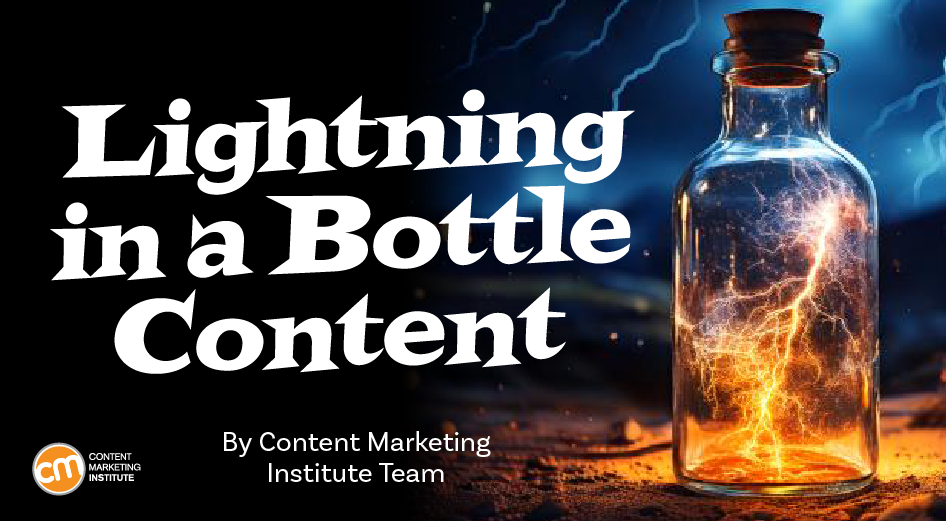
Fragmentation.
It’s the best word to describe today’s landscape of entertainment and information consumption.
Two years ago, user-generated content accounted for 39% of time spent on social media, according to research from the Consumer Technology Association. Last year, time spent watching online videos overtook television for the first time in history. And this year, if you think Netflix is the top streaming platform, think again. YouTube wins with 8.6% of streaming television consumption, surpassing Netflix’s 7.9% share.
All this fragmentation of content consumption takes people out of shared media and cultural experiences and puts them into echo chambers, which makes it tough for new content experiences to break through. Almost every viral, popular, or culturally resonant breakout seems like an accident — content lightning in a bottle.
Successful marketers follow the same memo. They understand fragmentation’s implications on paid advertising, search marketing, social media, and owned media.
So, how do you innovate on fragmented terrain?
Where do you focus that hard-earned marketing budget in a world where reaching your consumers feels a bit like playing Dungeons and Dragons? You know, when you awake in the early morning among the failed remnants of your competitors’ content marketing campaigns. You have content to create. What do you do?
We took that question to Robert Rose, CMI’s chief strategy advisor. Read on or watch for his take:
See a full content experience like Progressive and Lenovo
Over the last couple of months, I’ve talked a lot about moving your content experiences to the edge. In this article and a subsequent webinar, I discussed the trend in content and marketing of delivering valuable content experiences in their entirety beyond your website.
As much as I found it annoying, I said it was the oxygen in the room. You’ve got to focus more on designing the experiences on your “rented land properties.” That’s content at the edges. It puts increased pressure on making your owned media experiences even more valuable, such as making that FAQ with the special, you-can’t-get-it-anywhere-but-here content.
This week, Digiday made that point in a discussion on the fragmentation in marketing and media consumption: “Brand marketers are increasingly more receptive to alternative advertising options to reach consumers.”
While Digiday refers to these options as “non-traditional formats,” you know them better as content marketing efforts.
The article references the Are We Becoming Our Parents? campaign from Progressive.
Its wonderful fictional counselor, Dr. Rick (played by Bill Glass), has appeared as a guest on the Hot Ones, the popular YouTube series where the hosts interview celebrities as they eat increasingly spicy hot wings.
Digiday also talks about the Pop-Tarts Bowl, the college football bowl game that originated last season and returns on Dec. 28, as a wonderful example of a differentiated owned-media approach.
I would point to things like Autodesk’s State of Design & Make report, which is a primary focus in the company’s go-to-market strategy, and Lenovo’s Late Night I.T. series on YouTube as great examples.
Build bigger value when you swing for the fences
But back to the Digiday article. The kicker for me was two quotes from Evan Giordano, a strategist at the creative and ad agency Mother New York. “You can’t rely on advertising around a piece of culture anymore and expect that anyone and everyone will see it,” he said.
Eric followed that up with the approach to alternative formats “is pretty liberating because your creative team and your strategist have to think like product people; they have to conceptualize the outside of traditional formats.”
Yes, that’s long been the focus of how content marketers can build value in today’s world. I devote a module to thinking like a product manager in my content marketing strategy class.
In any event, the heart of these trends in alternative formats involves doing interesting, out-of-the-box experiences and delivering them on specially designed platforms at the edges and your owned media.
Here’s my question for you: As you plan for 2025, can you plan swing-for-the-fences, content-driven experience products? You can design them for YouTube, other social media, your owned media, or all of the above.
Think about what you can do that goes beyond another year of incrementally getting one more spot higher in search, decreasing your cost per lead by 5%, or testing a hundred button shapes and colors to bump conversion rates by 2%.
Those expected goals are important, no doubt. But maybe in a world of fragmentation, you can try something that’s not so, well, piecemeal.
HANDPICKED RELATED CONTENT:
Cover image by Joseph Kalinowski/Content Marketing Institute
